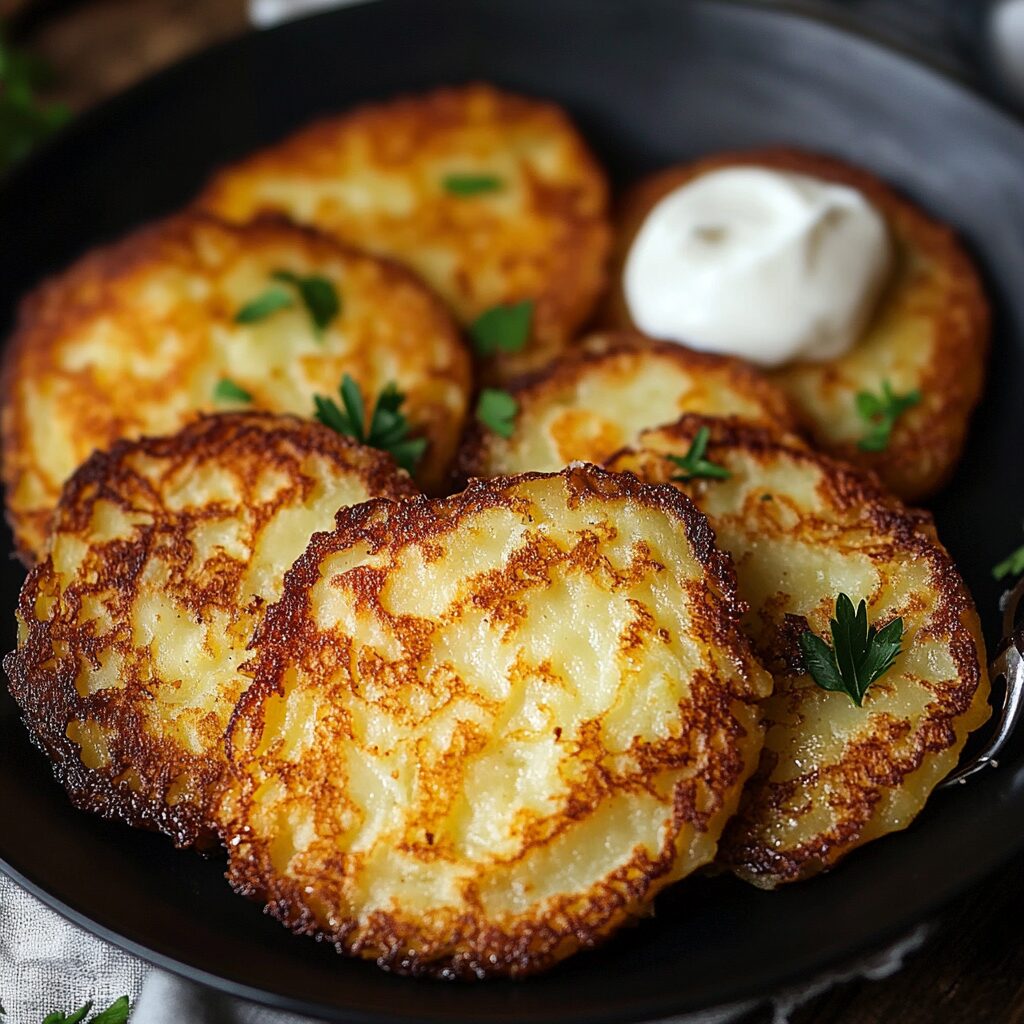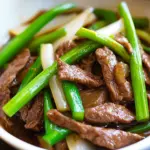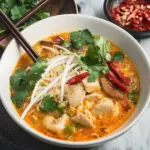German Potato Pancakes, also known as Kartoffelpuffer, are a beloved comfort food rooted in traditional European home cooking. Crisp on the outside with a tender, hearty center, these savory pancakes are made from shredded potatoes, onions, eggs, and flour, pan-fried to golden perfection. Whether served as a side dish, a brunch highlight, or even as a main course with toppings, they capture the rustic charm and satisfying simplicity of old-world kitchens.
What makes these pancakes so appealing is their versatility. Pair them with applesauce for a sweet-savory contrast, or go classic with a dollop of sour cream and fresh herbs. They’re also an excellent canvas for smoked salmon, fried eggs, or even shredded cheese. You can make them slightly thinner for extra crispness or thicker for a more potato-packed bite. Whether you’re revisiting your German roots or just craving something crispy and delicious, this dish delivers every time.
Full Recipe
Ingredients:
-
4 medium russet potatoes, peeled and grated
-
1 small onion, finely grated
-
2 large eggs
-
¼ cup all-purpose flour
-
Salt and pepper to taste
-
1 tablespoon chopped fresh parsley (optional)
-
Vegetable oil for frying
Directions:
-
Grate the potatoes and onion into a bowl. Using a clean kitchen towel, squeeze out as much liquid as possible from the mixture.
-
Add the eggs, flour, salt, pepper, and parsley to the grated potatoes and mix until well combined.
-
Heat a generous amount of oil in a skillet over medium-high heat.
-
Spoon 2-3 tablespoons of the potato mixture per pancake into the hot oil and flatten slightly with a spatula.
-
Fry until golden brown and crispy, about 3–4 minutes per side.
-
Drain on paper towels and serve hot, optionally with applesauce or sour cream.
Prep Time: 15 minutes | Cooking Time: 15 minutes | Total Time: 30 minutes
Kcal: 185 kcal per pancake | Servings: 4–6 pancakes
The Rich Heritage of German Potato Pancakes
German Potato Pancakes, also known as Kartoffelpuffer, are a time-honored staple in German cuisine that showcases the humble potato in its crispiest, most comforting form. Traditionally served as a snack, appetizer, or side dish, these savory pancakes are loved for their golden-brown crunch, soft interior, and rustic flavor that bridges the gap between hearty and wholesome. With origins tracing back to the rural regions of Germany, they were initially created as a way to use up leftover potatoes, but over time, they evolved into a cultural delicacy celebrated across all generations.
These pancakes are made by grating raw potatoes and mixing them with eggs, flour, and finely grated onions for a well-balanced savory flavor. They’re then fried to crispy perfection in hot oil, often served hot and fresh off the skillet. Their signature appeal lies in their deeply satisfying texture—crispy edges and a tender core—and the variety of toppings that accompany them, ranging from sweet applesauce to savory sour cream or even smoked fish. This flexibility makes them suitable for any occasion, whether a festive meal or a simple weekday snack.
Cultural Significance and Variations
In Germany, Kartoffelpuffer are especially popular during fall and winter markets, where they’re served hot at Christmas fairs (Weihnachtsmärkte) and street festivals. Children often enjoy them with a spoonful of applesauce, while adults might lean toward sour cream and chives or even pair them with beer as part of a hearty meal. In some German-speaking regions, such as Austria and parts of Switzerland, the recipe may include regional twists, like adding caraway seeds, nutmeg, or different types of flour for texture and flavor.
Beyond Germany, similar variations of potato pancakes exist in many cultures. In Jewish cuisine, latkes bear a close resemblance and are traditionally prepared during Hanukkah. Eastern European cuisines also offer their own interpretations, with additions like garlic, herbs, or cheese. What sets German Potato Pancakes apart is their simplicity and focus on crispness, often made thinner and crunchier than their Eastern European counterparts.
Why These Potato Pancakes Stand Out
The appeal of German Potato Pancakes lies in their balance of flavors and textures. The mild, starchy richness of potatoes pairs beautifully with the sweetness of onions and the richness of eggs. When fried, this combination develops a caramelized crust that’s deeply flavorful, while the inside remains soft and moist. The result is a pancake that’s filling without being heavy, indulgent without being greasy.
They also stand out for their adaptability. Whether you prefer them as part of a vegetarian meal or a meaty breakfast plate, they serve as the ideal base. Home cooks can modify the recipe by using different spices, fresh herbs, or even shredded vegetables like zucchini or carrots. The pancakes can be made large for a dinner plate or mini-sized for appetizers at a gathering. This makes them not only a beloved comfort food but also a versatile dish that can suit various dietary needs and meal plans.
Health Benefits and Nutritional Profile
Although potato pancakes are a fried dish, they can still offer nutritional value depending on how they are prepared. Potatoes themselves are rich in vitamin C, potassium, and dietary fiber, especially when left with the skin on. The inclusion of onions not only adds flavor but also brings antioxidants and antimicrobial properties. By frying them in high-quality oils such as avocado or sunflower oil and using moderate amounts of flour, you can maintain the integrity of the dish without excessive calories.
For those seeking a healthier alternative, these pancakes can be baked instead of fried, or pan-fried with minimal oil in a nonstick skillet. You can also replace the all-purpose flour with whole wheat or oat flour to increase the fiber content. Adding herbs like parsley, dill, or chives further boosts the nutritional profile, providing trace minerals and fresh flavor.
Serving Suggestions and Pairings
One of the most delightful aspects of German Potato Pancakes is their ability to complement both sweet and savory accompaniments. The most classic pairing in German homes is with homemade applesauce, which offers a sweet counterpoint to the salty, crispy pancakes. This sweet-savory harmony makes them especially appealing to children.
For a more savory presentation, sour cream, crème fraîche, or Greek yogurt make excellent toppings. Add freshly chopped chives, parsley, or even smoked salmon to elevate the dish into something more elegant. When served for brunch or lunch, pair the pancakes with sausages, scrambled eggs, or a fresh salad with mustard vinaigrette.
Drinks that complement the meal include crisp lagers, sparkling cider, or herbal teas. For a festive meal, a light Riesling or dry white wine can enhance the savory notes of the pancakes and their garnishes.
Occasions to Serve German Potato Pancakes
German Potato Pancakes are a crowd-pleaser perfect for various occasions. They are often enjoyed during Oktoberfest or Christmas markets, but you don’t need a festival to indulge. They make an excellent dish for:
-
Weekend family brunches
-
Holiday appetizers
-
Potluck dinners
-
School lunches (in mini form)
-
Cozy weekday meals
Since they can be made ahead and reheated in the oven, they’re also a convenient choice for meal prepping or entertaining. You can make a big batch and store leftovers in the refrigerator for up to three days or freeze them for future use.
Tips for Achieving the Perfect Pancake
To get the crispiest texture, it’s crucial to remove as much moisture as possible from the grated potatoes. This can be done by wrapping the shredded potatoes in a clean dish towel and squeezing until nearly dry. Too much moisture will lead to soggy pancakes that won’t crisp properly in the pan.
Another tip is to maintain medium heat while frying. If the oil is too hot, the outside will brown too quickly while the inside remains raw. If the oil is too cold, the pancakes will absorb too much and become greasy. Always allow the pancakes to drain on a paper towel after frying to remove excess oil.
You can also make your mixture ahead of time but be sure to keep it covered and chilled. To prevent discoloration of the potatoes, a small splash of lemon juice or vinegar can be added to the mix before cooking.
Modern Twists and Variations
Creative cooks and modern food lovers are always finding new ways to reinvent the classic German Potato Pancake. Here are some fun variations:
-
Cheesy Pancakes: Add shredded cheddar, mozzarella, or gouda to the batter.
-
Vegetable Medley: Incorporate grated carrots, zucchini, or parsnips for color and nutrition.
-
Spicy Kick: Add chili flakes, jalapeño, or even a touch of curry powder.
-
Gluten-Free: Use almond flour, chickpea flour, or potato starch instead of wheat flour.
-
Vegan Version: Replace eggs with flaxseed meal or a vegan egg substitute and enjoy a plant-based option.
Each version offers a new experience while preserving the dish’s heartwarming foundation.
Conclusion
German Potato Pancakes are a beautiful example of how simple ingredients can create a dish that’s both comforting and culturally rich. Their golden crunch, earthy flavor, and versatility have made them a staple across generations—not only in Germany but around the world. Whether served as part of a festive celebration, a family breakfast, or a weekday treat, Kartoffelpuffer brings warmth and satisfaction to the table.
By adjusting cooking methods and ingredients, you can tailor the dish to suit your dietary needs without sacrificing flavor. Whether you enjoy them traditionally with applesauce or creatively topped with gourmet garnishes, these potato pancakes never fail to impress. Their ease of preparation and timeless taste make them a must-try recipe that deserves a permanent spot in your culinary rotation.






